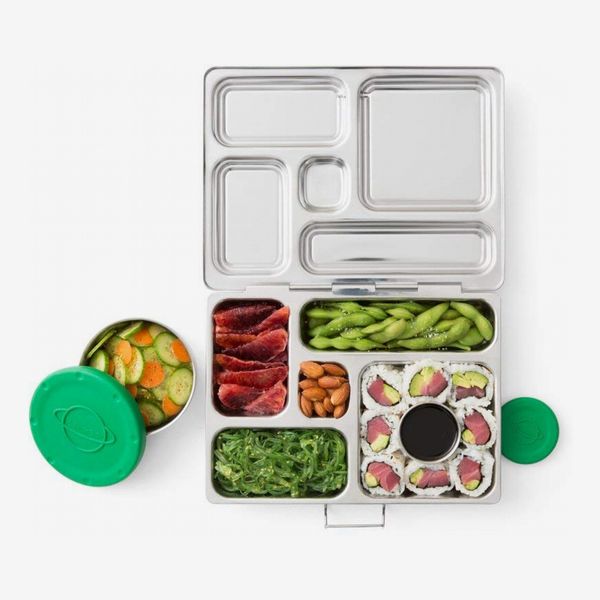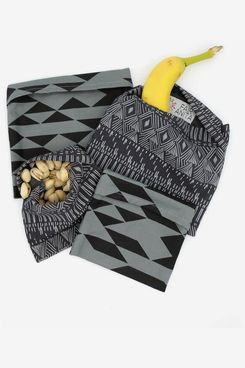
You know the feeling when your produce turns brown only a few days after you bought it? Or when the soup or smoothie you carefully packed for lunch ends up spilling on the inside of your bag? Or when you ready a week’s worth of office meals on Sunday night, only to have all of your mismatched Tupperware crash down on you when you open the cabinet? All of these problems can be solved by one thing: proper and efficient storage containers. We spoke with nutritionists, dietitians, and other meal-prep experts about the proper supplies for every scenario. They recommended the containers, lunchboxes, thermoses, and more that will keep you organized and your food tightly sealed and fresh. Read on for their picks.
Best containers for prepared meals
Whether you’re keeping your prepped meals in the fridge or the freezer for longer-term storage, experts recommend eco-friendly glass containers. “I prefer glass containers with locking lids because glass is easy to clean, reheat, and use to store produce and most foods without creating smells,” says Ashlee Piper, sustainability journalist and author of Give a Sh*t: Do Good. Live Better. Save the Planet. She pointed us toward the Glasslock containers, which have airtight lids.
Registered dietitian and nutritionist Rachel Paul, founder of College Nutritionist, agrees that glass is the way to go “to eliminate any potential plastic chemicals. Lock-lids are best, as well, to keep food at its freshest and to prevent leaking and spilling of liquids.” This set of glass containers (all safe for microwave, dishwasher, oven, and freezer) includes everything you’ll need to store a variety of dishes.
Pyrex, the favorite brand of Laura Mahoney, a health coach with the Noom weight-loss app, also sells containers in all different sizes. “For storing cooked foods, I prefer to use glass containers because you can seamlessly bring food from the refrigerator to the microwave, without having to transfer the contents,” says Mahoney. “The key is having a variety of shapes and sizes so that you have options depending on your needs.” Nutrition coach Erin Romeo, known on Instagram as the “food-prep princess,” likes Pyrex because “if you eat right out of the container instead of transferring your meal to a plate, you’ll only have one dish to wash. Speaking of washing, glass containers are super easy to clean and don’t retain food smells as much as plastic does.”
There are a few drawbacks to using glass, though. For nutrition expert and founder of NAO Wellness Nikki Ostrower, who says she’s tried “80 million different brands [of containers] and most of them are a nightmare,” heavy glass containers proved impractical to carry around all day in her backpack and difficult to store in her small New York City kitchen. Instead, she uses BPA-free, collapsible silicone Thin Bins that can also go in the microwave, dishwasher, and freezer. Best of all, she says, “when you’re done with your food, they collapse like an accordion,” making them easy to tote around and eliminating cabinet clutter.
Strategist kitchen-and-dining writer Emma Wartzman is a dedicated deli-container hoarder. If you buy restaurant-grade ones, they’re sturdy, microwavable, and dishwasher safe. They come in various sizes, which can accommodate fully prepped meals, leftover salad dressings, dry pantry goods, and more. They’re stackable, too, which makes them perfect for a smaller kitchen with minimal storage. And best of all, they have universal lids, which means you’ll never be without one. At only $17 for 36 containers, you also don’t have to be too precious about getting them back when you send home leftovers with friends.
Best containers for packing lunch
Once your lunch is ready to go, you’ll need a box to transport it to work or school without making a mess. Ostrower is a fan of the stainless-steel PlanetBox. “What I love about it is it makes food fun,” she says. “There are a few different ones to choose from depending on how big you want your lunch to be, it looks like a bento box, and it doesn’t leak.” The multiple compartments keep items separate and a round lidded container is included for hummus and other dips. This was the top pick of nearly all the experts in our lunchbox-focused roundup.
For another portable option, Piper recommends this set of three nesting metal boxes. “I love stainless-steel tiffins — stacking metal containers — for packing my lunches that don’t need to be heated,” she says. The three boxes can be used together or separately, depending on what’s on the menu.
If you want to reheat your lunch and only have access to an office microwave, go with these microwave- and dishwasher-safe, BPA-free containers, which come recommended by Amy Shapiro, a registered dietitian and nutritionist and the founder of Real Nutrition NYC. With divided compartments, these containers allow for customized lunch-packing, and the locking lids keep contents safe. They’re also available in bright, kid-friendly colors for school lunches.
An all-in-one lunchbox (including silverware) that Shapiro calls “incredible,” the Prepd Pack comes with three microwave-safe, leakproof food containers and a tiny one for sauces or salad dressings. The brand’s insertable cooling gel sticks keep food cold even when refrigeration isn’t possible.
If you mostly take sandwiches to work for lunch — or send them with your kid to school — consider these durable, washable sandwich bags, which come recommended by Shanika Graham, the mom and food writer who founded Orchids + Sweet Tea. “I love the fact that they are reusable, but they can also be tossed away because they’re fairly reasonably priced,” she says.
These cotton snack bags are perfect for storing sandwiches, nuts, fruit, or other small bites to bring on the go. “They’re so cute,” says LaToya Tucciarone, owner of SustainAble Home Goods in Atlanta, “and machine washable.”
Best containers for smoothies and soups
Even the most seasoned meal-prepper might feel hesitant about keeping a container full of juice or soup in the same bag as a laptop or important work papers, so finding the right vessel for holding liquids can be a challenge. Both Ostrower and and Shapiro rely on S’well bottles to keep soups and drinks hot, and smoothies and juices cold, for hours without spilling. Shapiro points out that the travel mug is especially good for meal prep. “It has a wide mouth so you can actually drink the thick liquid [of a smoothie],” she says. “You can also use it for soup, which is a great thing to meal-prep because you can get a lot of servings out of it.”
Ostrower also likes vacuum-sealed, insulated food jars from Thermos, which come in different sizes for both kids and adults. “They keep food hot and seal beautifully with no leakage,” she says.
Best containers for salads and salad dressings
A dry salad is a boring salad, but adding dressing before you pack your lunch can leave greens soggy and wilted. These tiny, leakproof, squeezable bottles are Paul’s picks for keeping your dressing separate until it’s time to eat. In a pinch, Shapiro says you can also use a clean travel toiletry tube.
Experts love mason jars for storing and toting all types of meals, and Shapiro specifically recommends the smaller ones for dressing. Mahoney says you can even use a larger, widemouthed jar for all of your salad ingredients, as long as you layer them right way: “You can place the dressing on the very bottom of the jar, then start by adding your sturdier contents that won’t become droopy from touching the dressing, like beans or harder vegetables.” She’ll also use them for an on-the-go breakfast like yogurt parfaits or overnight oats.
Even simpler than your standard mason jar, these French canning jars — recommended by Bea Johnson, author of Zero Waste Home — come with the lids attached, so there’s no separating the lids from the jars when washing them, and no chance of misplacing a lid.
Best produce containers
Aspiring meal-preppers often come home from the grocery store with bundles of fresh produce and the best intentions, only to find that their vegetables and fruit go bad faster than they can cook and eat them. To solve this problem, experts love Stasher bags with airtight seals, which help food stay fresher longer. “They’re silicone and are ideal replacements for disposable plastic zip-top bags,” says Piper. “I use them to pack lunches and snacks, store produce for smoothies in my freezer, and even for traveling.” Shapiro also uses them for storing and transporting chopped fruits and vegetables, and loves how versatile they are. “You can dishwash them, which I think is game-changing,” she says.
While Piper says you can wrap washed greens in linen dishcloths or napkins to keep them fresh, for a dedicated solution she likes these flax linen bags, designed to hold moisture and prevent spoiling. Use a dry bag for washed berries and a slightly damp one for herbs and veggies.
Strategist contributor Mattie Kahn is a fan of these cotton bags, which also keep your vegetables fresher longer. The method is the same as above: Wet the cloth, throw your veggies in, and put the bag in your crisper drawer. “I’ve made spinach last a week compared to three or four days,” Kahn says.
The Strategist is designed to surface the most useful, expert recommendations for things to buy across the vast e-commerce landscape. Some of our latest conquests include the best acne treatments, rolling luggage, pillows for side sleepers, natural anxiety remedies, and bath towels. We update links when possible, but note that deals can expire and all prices are subject to change.
Every editorial product is independently selected. If you buy something through our links, New York may earn an affiliate commission.

























